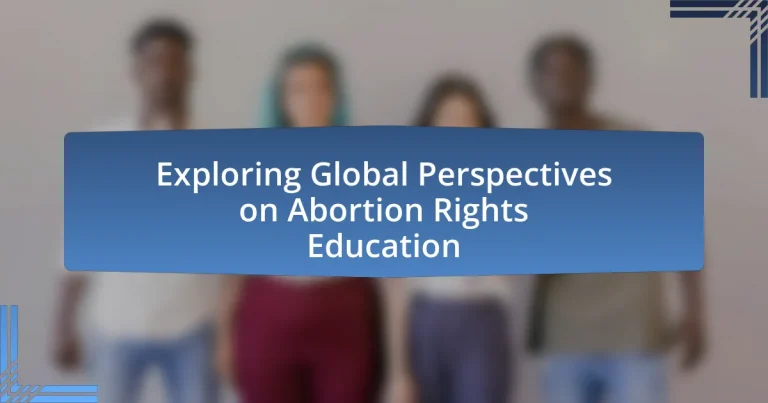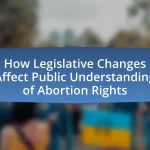The article explores global perspectives on abortion rights education, highlighting the significant variations influenced by legal, cultural, and religious factors across different regions. It examines how countries like Canada and the Netherlands promote comprehensive reproductive rights education, while restrictive laws and cultural stigmas in parts of Africa and Latin America hinder access to accurate information. The discussion includes the historical context shaping these perspectives, the role of government policies, and the impact of socio-economic factors on education access. Additionally, it addresses the challenges posed by misinformation and stigma, and outlines best practices and successful models for effective abortion rights education worldwide.
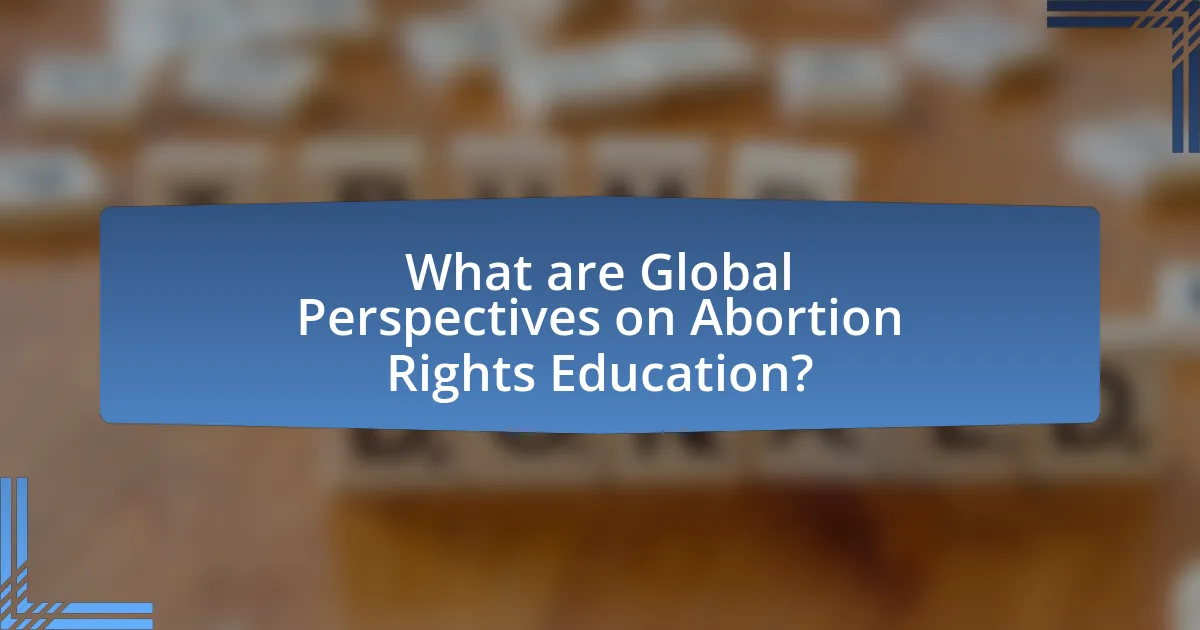
What are Global Perspectives on Abortion Rights Education?
Global perspectives on abortion rights education vary significantly across different regions and cultures, reflecting diverse legal, social, and ethical frameworks. In countries like Canada and the Netherlands, abortion is widely accepted, and education emphasizes reproductive rights and access to safe procedures, supported by comprehensive sexual education programs. Conversely, in regions such as parts of Africa and Latin America, restrictive laws and cultural stigmas hinder access to abortion education, often resulting in misinformation and unsafe practices. For instance, a 2020 report by the Guttmacher Institute highlighted that 40% of women in developing countries lack access to safe abortion services, underscoring the need for improved education and resources. These contrasting perspectives illustrate the critical role of context in shaping abortion rights education globally.
How do different cultures view abortion rights education?
Different cultures have varying perspectives on abortion rights education, influenced by religious, social, and political factors. In many Western countries, such as the United States and Canada, abortion rights education is often framed within the context of women’s rights and bodily autonomy, emphasizing the importance of informed choice. Conversely, in many conservative cultures, particularly in parts of Africa and the Middle East, abortion is viewed negatively, often associated with moral and religious objections, leading to limited or no education on the subject. For instance, a study by the Guttmacher Institute highlights that in countries with restrictive abortion laws, comprehensive sex education, including abortion rights, is frequently absent, resulting in misinformation and stigma surrounding the topic. This disparity illustrates how cultural beliefs shape the accessibility and content of abortion rights education globally.
What historical factors influence these cultural perspectives?
Historical factors that influence cultural perspectives on abortion rights education include colonial histories, religious beliefs, and significant legal milestones. Colonial histories often imposed foreign values and legal systems that shaped local attitudes towards reproductive rights, leading to a complex interplay between traditional practices and imposed norms. For instance, in many African nations, colonial laws criminalized abortion, which has had lasting effects on contemporary views. Additionally, religious beliefs play a crucial role; in regions where conservative religious ideologies dominate, such as in parts of Latin America and the Middle East, opposition to abortion is often rooted in theological doctrines. Significant legal milestones, such as the Roe v. Wade decision in the United States in 1973, have also influenced global discussions on abortion rights, prompting shifts in public opinion and policy in various countries. These historical factors collectively shape the diverse cultural perspectives on abortion rights education today.
How do religious beliefs shape views on abortion rights education?
Religious beliefs significantly influence views on abortion rights education by framing moral and ethical perspectives surrounding the issue. For instance, many religious traditions, such as Catholicism and certain Protestant denominations, advocate for the sanctity of life from conception, leading adherents to oppose abortion and support educational initiatives that reflect these values. Conversely, other faiths or more liberal interpretations may emphasize individual autonomy and the importance of informed choice, advocating for comprehensive education on abortion rights. Research indicates that religious affiliation correlates with attitudes toward abortion; a study by the Pew Research Center found that individuals with strong religious beliefs are more likely to oppose abortion compared to those with secular views. This divergence in beliefs shapes the content and focus of abortion rights education, often resulting in polarized approaches based on religious doctrine.
What role do governments play in abortion rights education?
Governments play a crucial role in abortion rights education by establishing policies, funding programs, and implementing educational initiatives that inform the public about reproductive rights. For instance, in countries like Canada, the government provides comprehensive sexual education that includes information on abortion, ensuring that citizens understand their rights and available services. Additionally, government agencies may collaborate with non-profit organizations to disseminate accurate information, counter misinformation, and promote access to safe abortion services. This involvement is essential for fostering informed decision-making and reducing stigma surrounding abortion, as evidenced by studies showing that comprehensive education leads to better health outcomes and increased awareness of reproductive rights.
How do laws and regulations vary across countries?
Laws and regulations vary across countries due to differences in cultural, political, and legal frameworks. For instance, in some countries like Canada and the Netherlands, abortion is legal and accessible, reflecting progressive views on reproductive rights, while in others, such as El Salvador and Poland, strict laws severely limit or completely ban abortion, often influenced by religious beliefs and conservative political ideologies. This disparity is evident in the Global Abortion Policies Database, which shows that 39 countries allow abortion on request, while 26 countries prohibit it altogether. These variations highlight how national contexts shape legal approaches to abortion rights and education.
What impact do government policies have on education about abortion rights?
Government policies significantly shape education about abortion rights by determining the curriculum, funding, and accessibility of information. For instance, in countries with restrictive abortion laws, educational content often omits comprehensive information about reproductive rights, leading to misinformation and stigma. Conversely, nations that support reproductive health education typically include abortion rights in their curricula, promoting informed decision-making among students. Research from the Guttmacher Institute indicates that comprehensive sex education, which includes discussions on abortion, leads to better health outcomes and reduced rates of unintended pregnancies. Thus, government policies directly influence the quality and scope of education regarding abortion rights, impacting societal attitudes and individual choices.
Why is abortion rights education important globally?
Abortion rights education is important globally because it empowers individuals to make informed decisions about reproductive health. This education fosters awareness of legal rights, health implications, and available options, which is crucial in regions where access to safe abortion services is limited. For instance, the World Health Organization reports that unsafe abortions contribute to approximately 47,000 deaths annually, highlighting the need for comprehensive education to reduce these risks. Furthermore, educating communities about abortion rights can challenge stigma and promote gender equality, ultimately leading to better health outcomes and social justice.
What are the health implications of inadequate abortion rights education?
Inadequate abortion rights education leads to significant health implications, including increased rates of unsafe abortions and associated complications. Lack of knowledge about safe abortion practices can result in individuals resorting to unregulated procedures, which the World Health Organization estimates contribute to approximately 47,000 deaths annually worldwide. Furthermore, inadequate education can perpetuate stigma and misinformation, hindering access to necessary healthcare services and support. This lack of access can exacerbate mental health issues, as individuals may experience anxiety, depression, and feelings of isolation due to their circumstances. Overall, insufficient education on abortion rights directly correlates with poorer health outcomes and increased mortality rates.
How does education affect public opinion on abortion rights?
Education significantly influences public opinion on abortion rights by shaping individuals’ understanding of reproductive health, ethics, and social justice. Higher levels of education correlate with more progressive views on abortion, as educated individuals are often exposed to diverse perspectives and critical thinking skills that encourage empathy and informed decision-making. Research indicates that individuals with college degrees are more likely to support abortion rights; for instance, a 2020 Pew Research Center study found that 70% of college-educated adults in the U.S. believe abortion should be legal in all or most cases, compared to 50% of those with a high school education or less. This trend suggests that education fosters a more nuanced understanding of the complexities surrounding abortion, leading to greater support for reproductive rights.
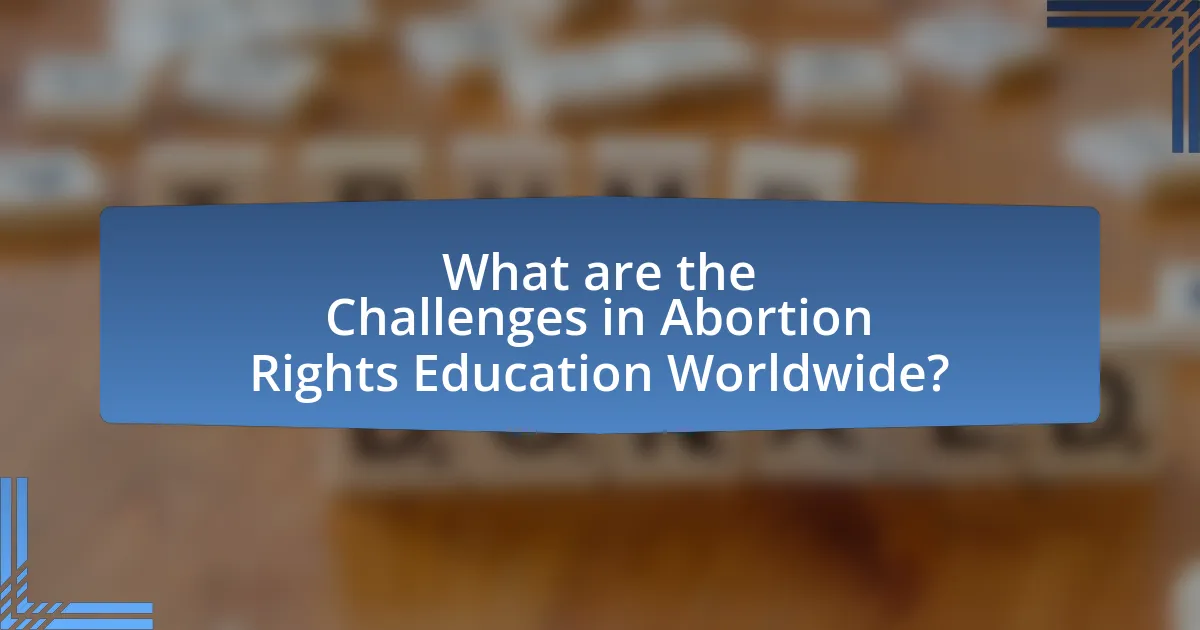
What are the Challenges in Abortion Rights Education Worldwide?
The challenges in abortion rights education worldwide include legal restrictions, cultural stigma, and misinformation. Legal restrictions often limit access to accurate information and resources, as many countries have laws that either criminalize abortion or impose strict regulations on its practice. Cultural stigma surrounding abortion can lead to social ostracism and discourage open discussions, further perpetuating ignorance about reproductive rights. Misinformation, often spread through unregulated online platforms and biased educational materials, contributes to a lack of understanding about the health implications and legal aspects of abortion. According to a report by the Guttmacher Institute, 40% of women in developing regions lack access to comprehensive reproductive health education, highlighting the urgent need for improved educational frameworks.
What barriers exist to effective abortion rights education?
Barriers to effective abortion rights education include misinformation, cultural stigma, and legal restrictions. Misinformation often spreads through social media and traditional media, leading to misconceptions about abortion procedures and rights. Cultural stigma surrounding abortion can discourage open discussions, making it difficult for individuals to seek accurate information. Legal restrictions in various regions limit access to educational resources and can criminalize the dissemination of information about abortion rights, further hindering education efforts. For instance, in countries with strict anti-abortion laws, educators may face legal repercussions for providing comprehensive information, which directly impacts the quality and availability of abortion rights education.
How do stigma and misinformation hinder education efforts?
Stigma and misinformation significantly hinder education efforts by creating barriers to open dialogue and accurate information dissemination. Stigma surrounding abortion often leads to fear and shame, discouraging individuals from seeking education or discussing their experiences. Misinformation, such as false claims about the health risks of abortion or its legal status, perpetuates confusion and distrust in educational resources. For instance, a study published in the journal “Contraception” found that misinformation about abortion can lead to increased anxiety and reluctance to access necessary services, ultimately undermining educational initiatives aimed at promoting reproductive health.
What role do socio-economic factors play in access to education?
Socio-economic factors significantly influence access to education by determining the resources available to individuals and families. For instance, families with higher income levels can afford educational materials, transportation, and extracurricular activities, which enhance learning opportunities. Conversely, low-income families often face barriers such as inadequate school facilities, limited access to technology, and the necessity for children to contribute to household income, which can hinder educational attainment. According to UNESCO, children from the poorest households are four times more likely to be out of school than those from the richest households, highlighting the stark disparities created by socio-economic status.
How do activists address these challenges?
Activists address challenges in abortion rights education by employing grassroots organizing, advocacy campaigns, and educational outreach. Grassroots organizing enables activists to mobilize community support and raise awareness about reproductive rights, often leading to local policy changes. Advocacy campaigns, such as lobbying for legislative reforms, aim to influence policymakers and secure legal protections for abortion access. Educational outreach initiatives focus on providing accurate information about reproductive health, countering misinformation, and fostering informed discussions within communities. For instance, organizations like Planned Parenthood have successfully implemented educational programs that empower individuals with knowledge about their reproductive rights, demonstrating the effectiveness of these strategies in overcoming barriers to abortion rights education.
What strategies are being implemented to improve education access?
Strategies being implemented to improve education access include the integration of technology in classrooms, the establishment of scholarship programs, and the development of community-based educational initiatives. For instance, online learning platforms have expanded access to quality education for students in remote areas, while scholarship programs help financially disadvantaged students enroll in schools. Additionally, community-based initiatives, such as mobile schools and adult education programs, address local educational needs and promote lifelong learning. These strategies collectively aim to reduce barriers to education and enhance opportunities for all learners.
How can technology be leveraged to enhance abortion rights education?
Technology can be leveraged to enhance abortion rights education through digital platforms, social media, and mobile applications that provide accurate information and resources. These tools facilitate the dissemination of educational content, allowing individuals to access reliable data about abortion rights, legal frameworks, and available services in their regions. For instance, organizations like Planned Parenthood utilize websites and social media campaigns to reach diverse audiences, offering interactive resources that clarify misconceptions and promote informed decision-making. Additionally, mobile apps can provide personalized information based on user location, ensuring that individuals receive contextually relevant guidance. This approach is supported by studies indicating that digital education can significantly increase awareness and understanding of reproductive rights, thereby empowering individuals to advocate for their rights effectively.
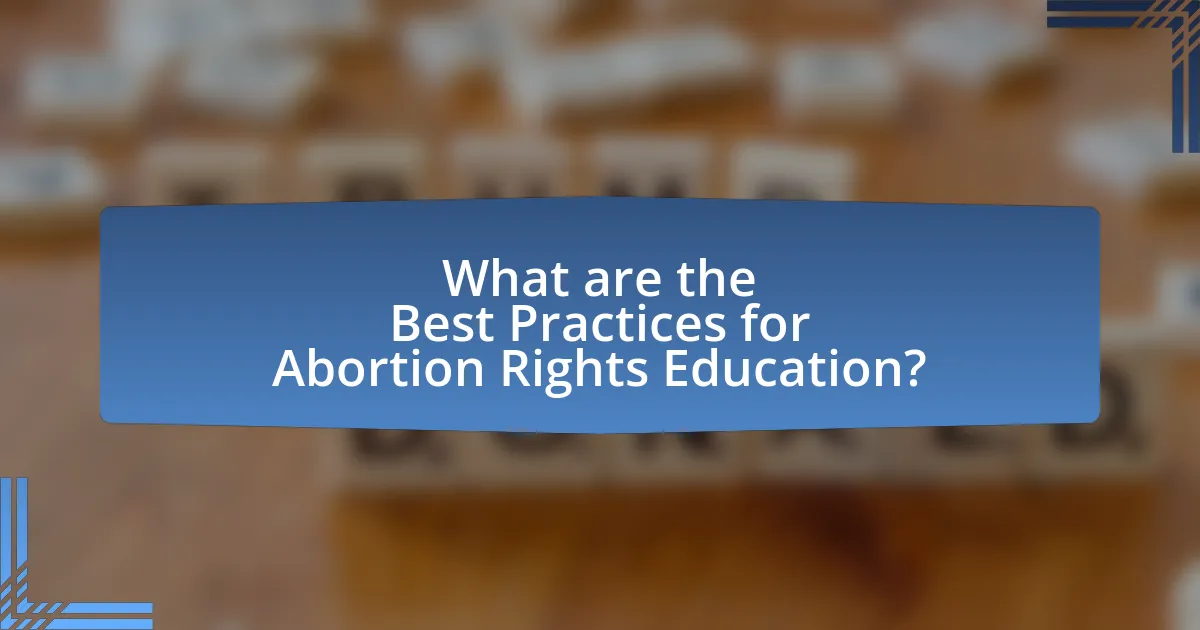
What are the Best Practices for Abortion Rights Education?
The best practices for abortion rights education include providing accurate, evidence-based information, fostering open dialogue, and ensuring accessibility to resources. Accurate information is crucial, as studies show that misinformation can lead to stigma and misunderstanding about abortion. Open dialogue encourages discussions that respect diverse perspectives, which is essential in a topic often surrounded by controversy. Accessibility to resources, including legal, medical, and emotional support, empowers individuals to make informed decisions. Research indicates that comprehensive sex education, which includes abortion rights, leads to better health outcomes and informed choices among young people.
What successful models of abortion rights education exist globally?
Successful models of abortion rights education globally include comprehensive sex education programs in countries like the Netherlands, which emphasize reproductive health and rights, leading to lower abortion rates. In Canada, the “Abortion Rights Coalition of Canada” provides resources and training for educators to effectively teach about abortion rights, contributing to informed public discourse. Additionally, the “Youth Coalition for Sexual and Reproductive Rights” operates internationally, advocating for youth-led education initiatives that empower young people with knowledge about their reproductive rights. These models demonstrate effectiveness through improved awareness and access to reproductive health services, as evidenced by studies showing increased understanding of abortion rights among participants.
How do these models adapt to local cultural contexts?
Models adapt to local cultural contexts by incorporating community-specific values, beliefs, and practices into their frameworks. For instance, educational programs on abortion rights often engage local stakeholders to understand cultural sensitivities and legal frameworks, ensuring that the content resonates with the target audience. Research shows that culturally tailored interventions, such as those developed in collaboration with local organizations, significantly improve acceptance and effectiveness, as evidenced by studies like “Cultural Adaptation of Interventions: A Systematic Review” by Benish et al., which highlights the importance of aligning educational content with local norms and practices.
What lessons can be learned from these successful initiatives?
Successful initiatives in abortion rights education demonstrate the importance of comprehensive, evidence-based information and community engagement. These initiatives show that providing accurate data about reproductive health leads to informed decision-making among individuals. For instance, programs that incorporate local cultural contexts and involve community leaders have been more effective in changing perceptions and increasing access to services. Research indicates that countries with robust sexual education programs, such as the Netherlands, experience lower rates of unintended pregnancies and abortions, highlighting the effectiveness of proactive education. Additionally, collaboration with healthcare providers ensures that individuals receive the necessary support and resources, further reinforcing the success of these initiatives.
How can educators effectively engage students in abortion rights discussions?
Educators can effectively engage students in abortion rights discussions by creating a safe and open environment for dialogue. This involves establishing ground rules that promote respect and active listening, allowing students to express diverse viewpoints without fear of judgment. Research indicates that when students feel safe, they are more likely to participate in sensitive discussions (Hess, D. E. & McAvoy, P., 2015, “The Political Classroom: Evidence and Ethics in Democratic Education”). Additionally, incorporating current events and case studies related to abortion rights can make the topic more relevant and relatable, encouraging critical thinking and informed debate among students.
What teaching methods are most effective for sensitive topics like abortion?
The most effective teaching methods for sensitive topics like abortion include facilitated discussions, case studies, and role-playing exercises. Facilitated discussions allow participants to express their views in a safe environment, promoting understanding and empathy. Case studies provide real-world contexts that help learners analyze the complexities surrounding abortion, fostering critical thinking. Role-playing exercises enable individuals to explore different perspectives and emotional responses, enhancing their ability to engage with the topic thoughtfully. Research indicates that these methods can lead to increased awareness and sensitivity, as evidenced by studies showing improved attitudes towards reproductive rights after such educational interventions.
How can educators create a safe space for open dialogue?
Educators can create a safe space for open dialogue by establishing clear ground rules that promote respect and confidentiality. This approach encourages students to express their thoughts without fear of judgment. Research indicates that when educators foster an environment of trust and openness, students are more likely to engage in meaningful discussions, particularly on sensitive topics like abortion rights. For instance, a study published in the Journal of Educational Psychology found that classrooms with established norms for respectful communication saw a 30% increase in student participation during discussions on controversial issues.
What resources are available for those seeking to educate on abortion rights?
Numerous resources are available for those seeking to educate on abortion rights, including organizations, websites, and educational materials. Notable organizations such as Planned Parenthood and the Guttmacher Institute provide comprehensive information on reproductive health and rights, including statistics, research, and advocacy tools. Additionally, the Center for Reproductive Rights offers legal resources and case studies that highlight the importance of abortion rights globally. Educational websites like Abortion Access Front and the National Abortion Federation also provide resources for educators, including toolkits and fact sheets that can be used to inform discussions on abortion rights. These resources are essential for understanding the complexities of abortion rights and for promoting informed dialogue on the subject.
